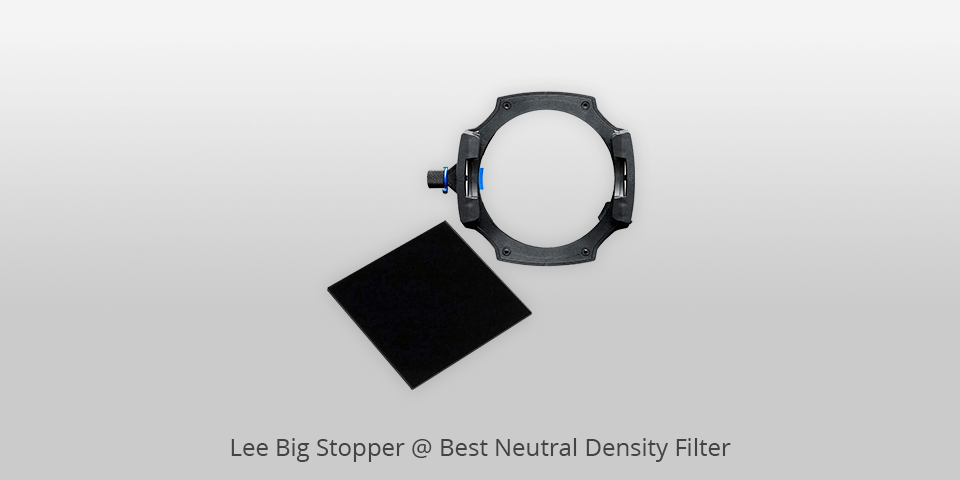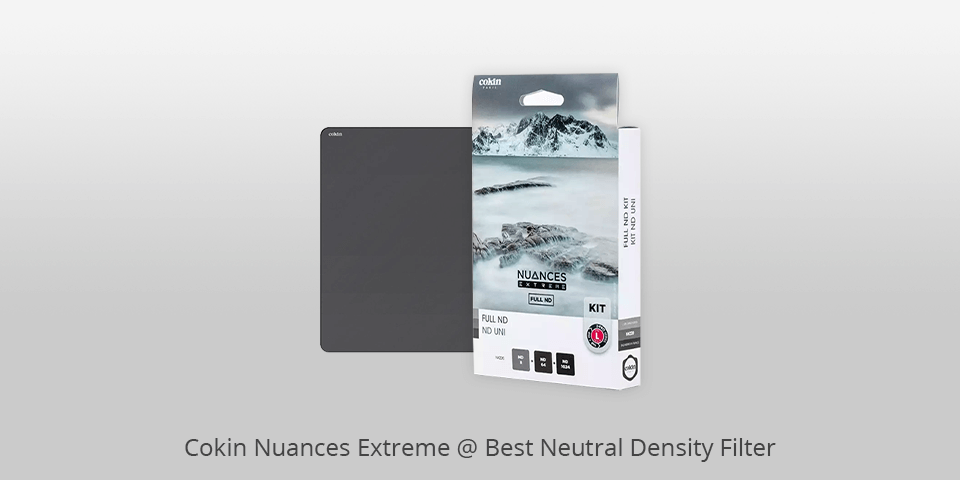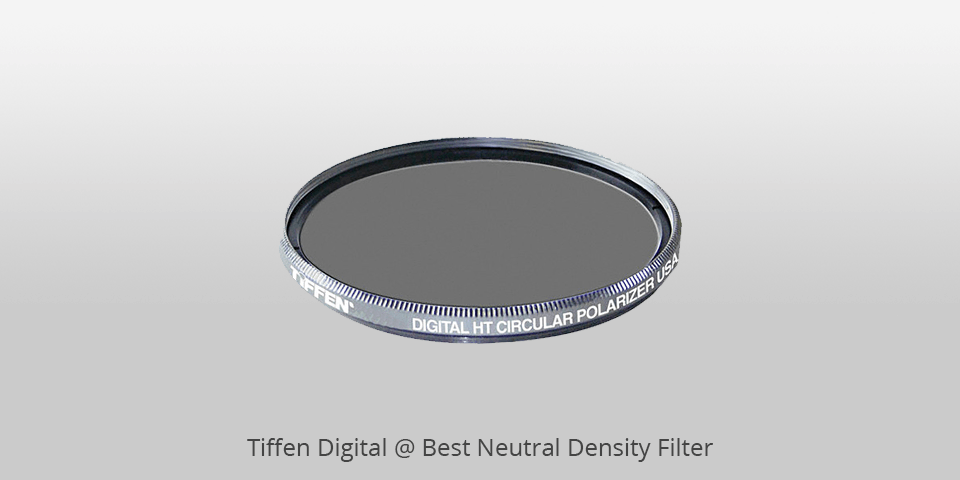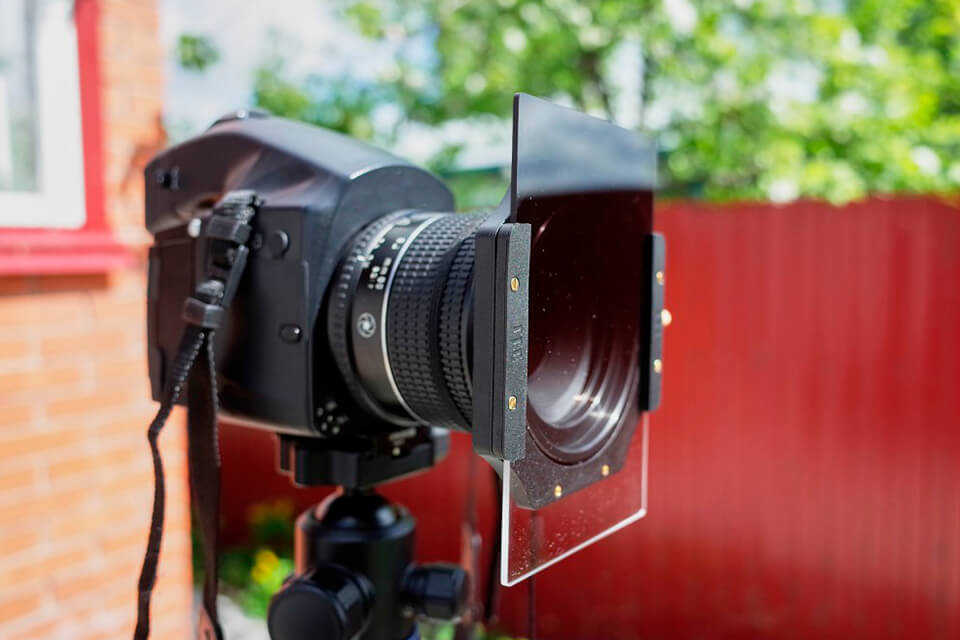Reduce the amount of light when taking long-exposure photos
If you want to forget about overexposure issues, try using the best neutral density filter when taking photos. By putting a dark filter in front of your lens, you can take long-exposure shots at f/16 stops as well as protect your lens and shutter. Many professional photographers create unusual effects using ND filters. You can buy a set for $50. Such filters allow you to capture photos with high color accuracy and good sharpness.
Neutral density filters have wide-range light-blocking capabilities. You may need to use a filter with 2 – 3 densities, depending on the situation and your needs. It will allow you to take photos with a shallow depth of field when using a wide aperture without overexposing your photos on sunny days. Using ND filters, you can make moving objects less visible. The best filters for landscape photography make moving objects blurrier.

Material: waterproof multi-coated optical glass | Thread Size: 100×100 mm | Form-Factor: rectangular | Exposure Reduce: 6, 10, 15 stops | Filter Factor/Density: 64 – 3200x/1.8 – 4.5
Lee is a British company that produces handmade filters that will serve you for years to come. The famous Big Stopper is a high-quality square filter that can be mounted with the help of a filter holder compatible with Lee filters. You can set up this holder with one hand. Its system includes adapters for popular wide-angle lenses that come with lens hoods.
By using the native app of this best neutral density filter, you can calculate the exposure that you need to use when employing Lee filters at any time of day to take pictures. These filters allow you to take clear images without any distortion along the edges of the frame. You can use them to take long-exposure shots. While you will need to buy a filter holder and an adaptive ring, you won’t find the ND filter that provides the same image quality.

Material: highly resistant tempered coated optical glass | Thread Size: 84×84, 100×100, 130×130 mm | Form-Factor: rectangular | Exposure Reduce: 1 – 10 stops | Filter Factor/Density: 1 – 1024x/0,3 – 3
The French company Cokin created legendary filter systems that became popular among photographers who prefer film cameras. They remain widely used even today. The filters from this lineup are made of shock-resistant mineral tempered glass that is 4 times more durable than other types of glass. The company also used metallic nano-coating that accounts for uniform density across the frame.
You can buy a holder, adapter, and 3 graduated filters that reduce the amount of light by 1 – 10 stops. The Cokin EVO holder allows you to use two filters at the same time. The special protective foam mask prevents light leaks. These filters can be used with various holders and lenses with different threads.

Material: chemically reinforces water-repellent multi-coated optical glass | Thread Size: 37 – 95 mm | Exposure Reduce: 1 – 16 2/3 stops | Filter Factor/Density: 2 – 100000x/0,3 – 5
Hoya is a well-known Japanese manufacturer of round screw-in ND filters. It has been releasing these filters for years and has a great reputation on the market. The ProND lineup stands out for its high-quality glass and black aluminum edge, which minimizes reflections. The metallic ACCU-ND coating from both sides reduces glare.
There are filters of different densities available, from 1 to 16.6 stops. They come at affordable prices. Every filter has a low profile that is even lower than the one that B+W and Marumi filters have. It accounts for some vignetting when you use it with a wide-angle lens. The Hoya ProND is the best option for those who use a lens on a non-standard size and don’t want to buy an adapter ring.

Material: chemically reinforces water-repellent multi-coated optical glass | Thread Size: 46 – 95 mm | Exposure Reduce: 1 – 5 stops | Filter Factor/Density: 2 – 32x/0,3 – 1,5
B+W ND Vario was released by a well-established German company Schneider Kreuznach. It’s a screw-in filter with a wide choice of sizes. It’s fitted with a thin brass ring that allows you to combine it with other filters. The ND Vario has a durable multi-coating (MRC) that effectively reduces reflections and other defects as well as repels dirt and water. It has 7 layers of nano-structured coating from both sides. The thin Schott glass accounts for higher optical transparency and color accuracy.
When using the XS-Pro mount, you will notice that a protracting front ring has markings that indicate different density levels. Using such filters, you can take wide-angle photos with a shallow depth of field. Such ND filters are easy to attach and disconnect, which makes them perfect for those who need to take photos quickly. The black, low-profile body minimizes the risk of vignetting.

Material: multi-coated water-repellent anti-fingertips German SCHOOT glass | Thread Size: 37 – 95 mm | Exposure Reduce: 1,5 – 10 stops | Filter Factor/Density: 3 – 1000x
The H&Y has been producing filters for other brands, however, recently, it has released an innovative series of filters with magnet frames and step adapters with a universal step-up ring (RevoRing). A magnetic filter adapter is compatible with square H&Y filters. The variable adapter VND+CPL consists of a lightweight aluminum ND filter and a polarizing filter with a new type of mount. This all-in-one filter is compatible with various H&Y accessories.
This system allows you to quickly switch filters thanks to the retractable blade mount. The filter is highly adjustable. It has a variable adapter, which allows you to use it with lenses of different sizes.

Material: high-quality ColorCore glass | Thread Size: 49 – 82 mm | Exposure Reduce: 2 – 4 stops | Filter Factor/Density: 0,6 – 1,2
If you have never used ND filters before, take a look at the basic Tiffen set that is suitable for experimenting. It’s quite affordable and includes three screw-in filters that can block a low and average amount of light. A 4-stop filter is suitable for taking long-exposure shots on a sunny day, while a 2-stop filter will come in handy for the situations when you want to use a lens with a fixed focal length on a sunny day but your camera doesn’t support ultra-high shutter speeds.
The Tiffen filters have decent build quality thanks to the aluminum edge. However, it could have been better. While these filters might produce unwanted color casts, you can fix this issue during post-processing provided you shoot photos in RAW.

Material: CinemaSeries fused quartz glass | Thread Size: 67 – 82 mm | Exposure Reduce: 2 – 9 stops | Filter Factor/Density: 4 – 512x/0,6 – 2,7
If you value image quality, the PolarPro is the best ND filter for your needs. It allows you to significantly improve the quality of your images. The filter has a durable build and thick ribbed edges that help you hold it in place when removing it. Thanks to the special coating, you won’t notice any unwanted color casts and other defects. This filter is also protected against shock-impact, dust, and water. It can be rotated smoothly without any noise. Besides, it allows you to control vignetting.
The Peter McKinnon filter has superb build and design quality. You will see the density of the filter written on the copper coating of an aluminum ring. The cap is made of rubber. The filter comes with a protective case. You won’t notice any cross-polarization issues and will be impressed by the level of detail even at low density. This low-profile filter is perfect for wide-angle lenses.
| IMAGE | NAME | FEATURES | |
|---|---|---|---|

|
Lee LEE100 Stopper
OUR CHOICE
|
CHECK PRICE → | |

|
Cokin Nuances Extreme
DURABLE
|
CHECK PRICE → | |

|
Hoya PROND
AFFORDABLE
|
CHECK PRICE → |
Filters differ in shapes, sizes, mounts, and density, which directly impacts how much light they can block. Their main purpose lies in reducing the amount of light that gets to the camera lens. The best filters should support high color accuracy without affecting the overall image quality or sharpness.
If an ND filter is of low quality, it might make colors less accurate, create a vignette effect and reduce sharpness, which is why you should be extremely careful when making your choice.
This parameter is measured in F-stops. It ranges from 1 to 10 with 1 stop between them. A lens might have unusual lens density, such as 16 2/3. A neutral density filter with a low aperture value of up to 4 blocks most of the light. It allows you to take photos on a sunny day with a shallow depth of field. If you want to take photos with a wide aperture, you can select a filter with a higher aperture value of 7-10. It will reduce the shutter speed and allow you to shoot blurry moving objects.
You need to select an ND filter depending on the photography genre you specialize in, light conditions, and the type of lens you use. Unlike videographers, landscape photographers need to use a lens with a high optical density. There are different neutral density filters that have fixed, variable, or adjustable densities. When using fixed ND filters, you won’t be able to change the width of aperture. They block a specific light wavelength. You need to experiment with density if you want to achieve different effects.
Variable filters, or faders, consist of two rotating polarizing filters, which allows you to adjust them from 2 to 8 stops. They are suitable for adjusting video exposure and allow you to block light more effectively when using a wide aperture. Such filters block more light if you compare them with fixed filters as you can adjust aperture and shutter speed.

There are square and round filters. The latter are easier to use, which makes them suitable for those who often need to switch filters. They are more compact and usually don’t leak light. However, they can be used only with special lenses that have a fixed filter thread. If you want to adapt your filter for other lenses or combine several filters, you can use step-up rings to adapt a large-size filter to a small-size lens. However, you won’t be able to do the opposite.
Square filters have better quality and can be fixed with the help of a special filter mount that can be used almost with any lens. Such mounts can fix several filters at the same time thanks to a filter ring adapter. It allows you to combine graduated and diffusion filters or use them with polarizing filters. Make sure that the filter is fixed securely to prevent light leaks.
Durable filters are made of high-quality optical glass covered by multiple layers of anti-glare coating. Thanks to this coating, a lens can block high-intensity light, repel dirt and moisture, and protect the lens from shock impact. The thinner the glass element is, the less distorted your image will be. If a lens has a uniform density, it will allow you to capture photos without noticeable aberrations.
It’s better to use a neutral density filter with dark thin aluminum or steel housing, which makes it more durable and prevents light from overexposing your image from the side. A narrow profile allows it to minimize vignetting. If there are still some unwanted color casts in your photos, you can fix them during post-processing. However, it might be more difficult to fix defects caused by the poor quality of a glass element, such as non-uniform density or a protruding lens profile.

Powerful filters are perfectly suitable for long-exposure landscape shots. They will allow you to capture a smooth water surface, do cloud photography, shoot car light trails, and capture ghost-like passersby in public places. Filters with a small number of stops will come in handy for taking portrait photos on a sunnys day. Portrait photographers and videographers use ND filters for taking photos with a shallow depth of field when the sun shines brightly. You can use a wider aperture without setting the shutter speed to the highest values. It will allow you to blur the background without overexposing your subject or making it out of focus.
It depends. An in-built filter usually blocks 2-3 stops of light. It will suffice for experimenting, but you won’t be able to take ultra-long-exposure shots on a day with changeable weather. This is why it’s recommended to buy a new filter.
A 6-stop lens is an all-in-one solution, which explains its popularity among landscape photographers. If you want to capture minimalist urbanscapes or abstract landscapes and don’t need to give your photos a natural feel, you will need to use a filter that had 10 or more stops. The best option for portrait photographers, videographers, and everyone who likes capturing footage during the golden hour is a 3-stop ND filter.